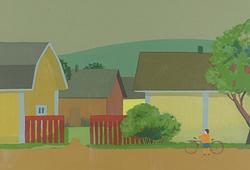Stefan Johansson
Portrait of a girl in profile, sketch
Likely executed in the 1920s. Later frame. Drawing and watercolour on canvas 23 x 28 cm.
Provenance
Inherited from the current owner's mother, who lived in the same house as Stefan Johansson on Älvgatan in Karlstad.
Literature
Stefan Hammenbeck (Ed.), "Stefan Johansson. Bara tiden och livet förslog", 2007, cf. "Portrait of a Young Girl", 1934.
Folke Holmér, "En bok om Stefan Johansson", 1958, compare "Porträtt av kanslisekreteraren A. K. Borgström (August Chrysosemus Borgström)", illustrated p. 79.
More information
The current portrait of a young girl is an unsigned sketch executed in pencil and watercolour on canvas. It was created in the early stages of Stefan Johansson's "wash technique", where he had not yet washed out the canvas in all layers, hence the pencil lines are still faintly visible. The work bears similarities to other sketches from the mid-1920s and is executed on the coarse linen canvas that the artist preferred to use at that time.
Stefan Johansson's limited production can primarily be divided into four thematic areas: interiors and cityscapes in compositions with electric light, portraits, and forest landscapes. The majority of portraits depict the artist's mother, until her death in 1924, but the production also includes a number of portraits of friends and some commissioned works.
Despite receiving formal training at Konstfack in his early years, Stefan Johansson considered himself self-taught, an autodidact, which can be linked to the technique he developed early on. During several trips to Italy in 1909-10 and 1913, he studied the objectivity of Renaissance painting, and he experimented with tempera and watercolour on panel and paper. He then transferred this technique to canvas, which would become his hallmark. By experimenting and diluting the paint with various types of solvents, he achieved the artist's typical expression where the lightness of the paint allows the texture of the canvas to emerge. Johansson called his new technique "wash painting". On prepared canvases with an "absorbent" base, he painted layer upon layer of tempera and watercolour. Gradually, he washed the canvas with a sponge to achieve his vision and give the linen threads the saturation he sought. Stefan Johansson did not, as far as is known, use a camera as an aid, but worked from a drawn sketch that was transferred onto the canvas.































